登録情報 データベース : PDB / ID : 6tsgタイトル Crystal structure of Peroxisome proliferator-activated receptor gamma (PPARG) in complex with TETRAC Peroxisome proliferator-activated receptor gamma キーワード / / / / / / 機能・相同性 分子機能 ドメイン・相同性 構成要素
/ / / / / / / / / / / / / / / / / / / / / / / / / / / / / / / / / / / / / / / / / / / / / / / / / / / / / / / / / / / / / / / / / / / / / / / / / / / / / / / / / / / / / / / / / / / / / / / / / / / / / / / / / / / / / / / / / / / / / / / / / / / / / / / / / / / / / / 生物種 Homo sapiens (ヒト)手法 / / / 解像度 : 2.98 Å データ登録者 Chaikuad, A. / Gellrich, L. / Arrowsmith, C.H. / Edwards, A.M. / Bountra, C. / Merk, D. / Knapp, S. / Structural Genomics Consortium (SGC) ジャーナル : J.Med.Chem. / 年 : 2020タイトル : l-Thyroxin and the Nonclassical Thyroid Hormone TETRAC Are Potent Activators of PPAR gamma.著者: Gellrich, L. / Heitel, P. / Heering, J. / Kilu, W. / Pollinger, J. / Goebel, T. / Kahnt, A. / Arifi, S. / Pogoda, W. / Paulke, A. / Steinhilber, D. / Proschak, E. / Wurglics, M. / Schubert- ... 著者 : Gellrich, L. / Heitel, P. / Heering, J. / Kilu, W. / Pollinger, J. / Goebel, T. / Kahnt, A. / Arifi, S. / Pogoda, W. / Paulke, A. / Steinhilber, D. / Proschak, E. / Wurglics, M. / Schubert-Zsilavecz, M. / Chaikuad, A. / Knapp, S. / Bischoff, I. / Furst, R. / Merk, D. 履歴 登録 2019年12月20日 登録サイト / 処理サイト 改定 1.0 2020年7月22日 Provider / タイプ 改定 1.1 2024年1月24日 Group / Database references / Refinement descriptionカテゴリ chem_comp_atom / chem_comp_bond ... chem_comp_atom / chem_comp_bond / database_2 / pdbx_initial_refinement_model Item / _database_2.pdbx_database_accession
すべて表示 表示を減らす
 データを開く
データを開く 基本情報
基本情報 要素
要素 キーワード
キーワード 機能・相同性情報
機能・相同性情報 Homo sapiens (ヒト)
Homo sapiens (ヒト) X線回折 /
X線回折 /  シンクロトロン /
シンクロトロン /  分子置換 / 解像度: 2.98 Å
分子置換 / 解像度: 2.98 Å  データ登録者
データ登録者 引用
引用 ジャーナル: J.Med.Chem. / 年: 2020
ジャーナル: J.Med.Chem. / 年: 2020 構造の表示
構造の表示 Molmil
Molmil Jmol/JSmol
Jmol/JSmol ダウンロードとリンク
ダウンロードとリンク ダウンロード
ダウンロード 6tsg.cif.gz
6tsg.cif.gz PDBx/mmCIF形式
PDBx/mmCIF形式 pdb6tsg.ent.gz
pdb6tsg.ent.gz PDB形式
PDB形式 6tsg.json.gz
6tsg.json.gz PDBx/mmJSON形式
PDBx/mmJSON形式 その他のダウンロード
その他のダウンロード 6tsg_validation.pdf.gz
6tsg_validation.pdf.gz wwPDB検証レポート
wwPDB検証レポート 6tsg_full_validation.pdf.gz
6tsg_full_validation.pdf.gz 6tsg_validation.xml.gz
6tsg_validation.xml.gz 6tsg_validation.cif.gz
6tsg_validation.cif.gz https://data.pdbj.org/pub/pdb/validation_reports/ts/6tsg
https://data.pdbj.org/pub/pdb/validation_reports/ts/6tsg ftp://data.pdbj.org/pub/pdb/validation_reports/ts/6tsg
ftp://data.pdbj.org/pub/pdb/validation_reports/ts/6tsg
 リンク
リンク 集合体
集合体
 要素
要素 Homo sapiens (ヒト) / 遺伝子: PPARG, NR1C3 / プラスミド: pNIC28-Bsa4 / 発現宿主:
Homo sapiens (ヒト) / 遺伝子: PPARG, NR1C3 / プラスミド: pNIC28-Bsa4 / 発現宿主: 
 X線回折 / 使用した結晶の数: 1
X線回折 / 使用した結晶の数: 1  試料調製
試料調製 シンクロトロン / サイト:
シンクロトロン / サイト:  SLS
SLS  / ビームライン: X06DA / 波長: 1 Å
/ ビームライン: X06DA / 波長: 1 Å 解析
解析 分子置換
分子置換 ムービー
ムービー コントローラー
コントローラー



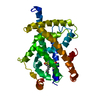

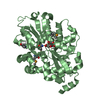
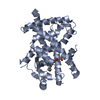
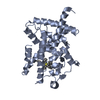
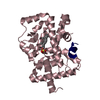

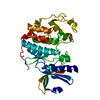
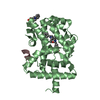
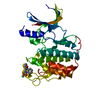
 PDBj
PDBj


